|
Home > Guides > Urban Gardening > Rooftop Gardening Guide > Rooftop Survival Gardening Guide |
|
Rooftop Survival Gardening Guide |
Vegetable  Organic Organic  Farming Farming  Survival Survival |
Rooftop gardening is similar to other types of container gardening with some notable exceptions. The first is the wind conditions that are inherent to such locations. Unlike ground-level spots like patios, rooftops see considerable gusts that can cause damage to all but the most sturdy growers. Higher rooftops will see considerably more wind than lower locations. When scouting your rooftop for the best place for your garden, avoid spots that are exposed to the direct wind in open expansive areas. The most ideal locations will be in close proximity to some type of shelter or wind block.
|
 |
|
|
| |
|
|
| |
|
|
| |
Rooftop Gardening Guide
GROWING NOTES
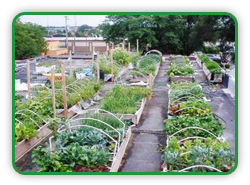 Rooftop gardens are likely to be exposed to more intense sunlight than those at ground level. Such light is less likely to be filtered by trees or other covering, potentially generating heat levels that can be dangerous to growing plants. If this proves to be the case, it may be wise to invest in a thin shade cloth or netting to provide some protection to your crops. The surface of the rooftop also becomes especially important as dark materials will absorb most sunlight and create a very hot, arid environment. Rooftop gardens are likely to be exposed to more intense sunlight than those at ground level. Such light is less likely to be filtered by trees or other covering, potentially generating heat levels that can be dangerous to growing plants. If this proves to be the case, it may be wise to invest in a thin shade cloth or netting to provide some protection to your crops. The surface of the rooftop also becomes especially important as dark materials will absorb most sunlight and create a very hot, arid environment.
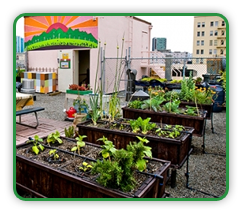 Hot, sunny conditions on rooftops can quickly cause plants to dry out. There are several means to address this. Perhaps the most important point to promote good water retention is through the soil. Rooftop gardens should be grown in a lightweight medium that has good water retention. To improve water retention, soil can be amended with a small amount of vermiculite. Self-watering containers are another means to keep your plants moist. Such containers typically need less attention than traditional watering, and provide a source of water that simulates patterns in nature. To protect from moisture loss at the surface of the soil, a layer of mulch can be evenly spread over the surface of the soil. Hot, sunny conditions on rooftops can quickly cause plants to dry out. There are several means to address this. Perhaps the most important point to promote good water retention is through the soil. Rooftop gardens should be grown in a lightweight medium that has good water retention. To improve water retention, soil can be amended with a small amount of vermiculite. Self-watering containers are another means to keep your plants moist. Such containers typically need less attention than traditional watering, and provide a source of water that simulates patterns in nature. To protect from moisture loss at the surface of the soil, a layer of mulch can be evenly spread over the surface of the soil.
|
| |
|
|
|
| |
|
|
|
|
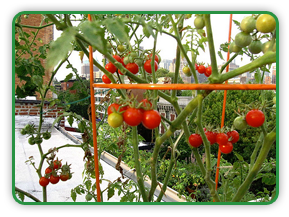 Gardeners seeking self-sufficiency from rooftop-grown fruits and vegetables must be extraordinarily diligent. As with 'casual' container gardening, limited space and sunlight are the principle challenges. Additionally, the containers, soil, accessories for wind protection, soil amendments, fertilizers and other accessories may present a considerable financial investment that should be considered prior to sowing. This not to diminish the long-term productivity or worthiness of such investment. With repeated harvests, and proper recycling of soil, a rooftop garden designed for self-sufficiency will pay for itself many times over. Gardeners seeking self-sufficiency from rooftop-grown fruits and vegetables must be extraordinarily diligent. As with 'casual' container gardening, limited space and sunlight are the principle challenges. Additionally, the containers, soil, accessories for wind protection, soil amendments, fertilizers and other accessories may present a considerable financial investment that should be considered prior to sowing. This not to diminish the long-term productivity or worthiness of such investment. With repeated harvests, and proper recycling of soil, a rooftop garden designed for self-sufficiency will pay for itself many times over.
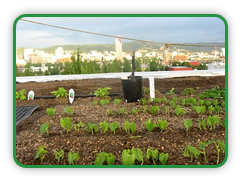 Carefully planning and executing an efficient growing strategy are the keys to successful rooftop gardening. To get started, carefully assess your available space, observing the daily and yearly light cycles. In the northern hemisphere, southern exposure will generally have the longest duration and greatest intensity. Natural sunlight should be abundant in most rooftop locations. In general, growing plants should receive, at the very minimum 5-6 hours of sunlight each day. This should be easily possible in most rooftop locations, as high levels of sunlight and potentially windy conditions highlight the need for careful measures to retain water. Carefully planning and executing an efficient growing strategy are the keys to successful rooftop gardening. To get started, carefully assess your available space, observing the daily and yearly light cycles. In the northern hemisphere, southern exposure will generally have the longest duration and greatest intensity. Natural sunlight should be abundant in most rooftop locations. In general, growing plants should receive, at the very minimum 5-6 hours of sunlight each day. This should be easily possible in most rooftop locations, as high levels of sunlight and potentially windy conditions highlight the need for careful measures to retain water.
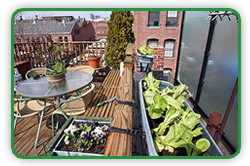 Once you develop a sense of how much light will be available for growing, you can begin to determine what type of container to use. For a truly self-sufficient garden, you will likely need several medium to large-sized raised beds or similar containers. When buying soil, your most economical choice will likely come from a local soil company rather than buying individual bags from a garden center. When growing food, select a medium that is fairly lightweight, well-drained, fertile and rich in organic matter. Typical soil from your yard will is not likely to make an ideal choice due to excessive clay content. Once you develop a sense of how much light will be available for growing, you can begin to determine what type of container to use. For a truly self-sufficient garden, you will likely need several medium to large-sized raised beds or similar containers. When buying soil, your most economical choice will likely come from a local soil company rather than buying individual bags from a garden center. When growing food, select a medium that is fairly lightweight, well-drained, fertile and rich in organic matter. Typical soil from your yard will is not likely to make an ideal choice due to excessive clay content.
|
|